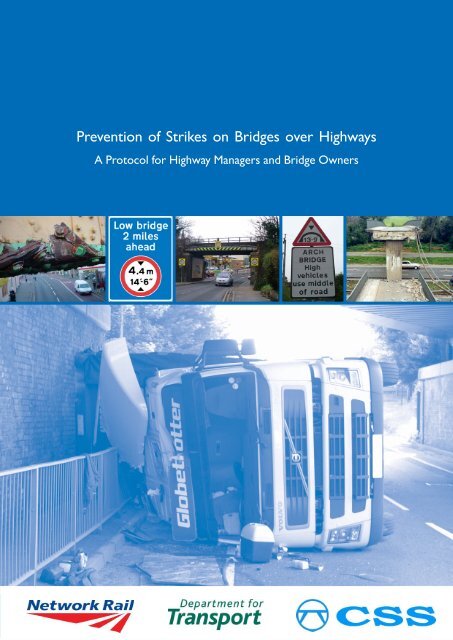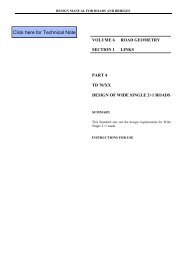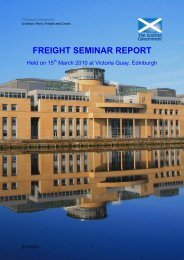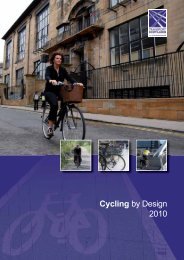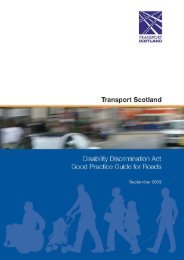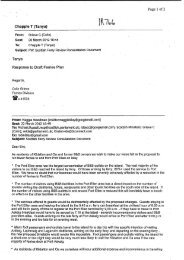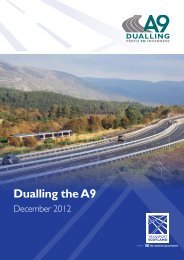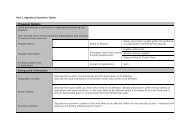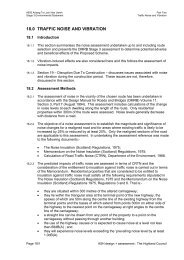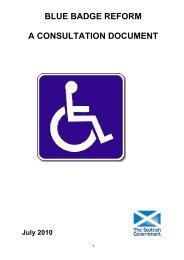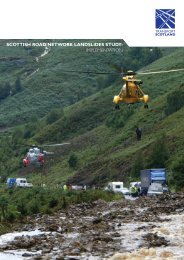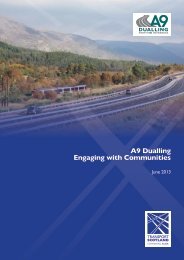A Protocol for Highway Managers and Bridge Owners - Transport ...
A Protocol for Highway Managers and Bridge Owners - Transport ...
A Protocol for Highway Managers and Bridge Owners - Transport ...
- No tags were found...
You also want an ePaper? Increase the reach of your titles
YUMPU automatically turns print PDFs into web optimized ePapers that Google loves.
Prevention of Strikes on <strong>Bridge</strong>s over <strong>Highway</strong>sA <strong>Protocol</strong> <strong>for</strong> <strong>Highway</strong> <strong>Managers</strong> <strong>and</strong> <strong>Bridge</strong> <strong>Owners</strong>A <strong>Protocol</strong> <strong>for</strong><strong>Highway</strong> <strong>Managers</strong> <strong>and</strong> <strong>Bridge</strong> <strong>Owners</strong>Purpose:Scope:To give guidance <strong>and</strong> advice to highway managers <strong>and</strong> bridge owners to minimisestrikes on bridges that span public highways.• The guidance is intended <strong>for</strong> all highway authorities <strong>and</strong> <strong>for</strong> all local authorities,transport authorities <strong>and</strong> other public authorities <strong>and</strong> private companieswho own bridges over public highways.• Additionally, the advice is pertinent to private l<strong>and</strong>owners who have accessways under bridges carrying railways or public highways.• The guidance applies to all bridges, with <strong>and</strong> without headroom signs, overvehicular highways.ContentsPage1.0 Introduction 22.0 <strong>Highway</strong> repairs under bridges; bridgework over highways 33.0 Signing of restricted headroom at bridges 54.0 Maintenance of signs 115.0 Other protection techniques 126.0 Distractions from advertising 127.0 Lighting in the vicinity of railways <strong>and</strong> under bridges 138.0 Temporary works <strong>and</strong> working practices 139.0 Joint working with Network Rail, London Underground Ltd 14<strong>and</strong> other bridge owners10.0 Other important considerations 1511.0 Action to take when in<strong>for</strong>med of a bridge strike 1612.0 Other useful documents 17Bibliography 19APPENDIX A: Surfacing activities under bridges over highways 21APPENDIX B: Additional options <strong>for</strong> protecting against bridge strikes 23APPENDIX C: Sample sign inspection report <strong>for</strong>m 26APPENDIX D: Examples of sites where signing could be improved 30APPENDIX E: TRL - bridge audit check sheet 32Registration, feedback <strong>and</strong> contacts 361
Prevention of Strikes on <strong>Bridge</strong>s over <strong>Highway</strong>sA <strong>Protocol</strong> <strong>for</strong> <strong>Highway</strong> <strong>Managers</strong> <strong>and</strong> <strong>Bridge</strong> <strong>Owners</strong>1.0 Introduction1.1 There is no legislation limiting the height of vehicles which can travel on the roadsin the UK or requiring drivers to notify or seek approval to travel in respect of anythreshold in vehicle height. Because of this, there are a number of issues that need tobe clearly stated, understood <strong>and</strong> addressed where roads go under bridges. This isparticularly the case <strong>for</strong> the prevention of bridge strikes, the consequences of whichare always costly <strong>and</strong> which can be fatal <strong>for</strong> both the driver of the vehicle <strong>and</strong> thepeople on or under the bridge in passing rail or road traffic.1.2 The following protocol seeks to identify these issues <strong>and</strong> recommend practices <strong>and</strong>procedures which, if followed, will contribute towards the prevention of bridge strikes,thereby ensuring greater safety <strong>for</strong> all travellers.1.3 Whilst there is no one panacea to the problems of bridge strikes, it is important toincrease driver underst<strong>and</strong>ing <strong>and</strong> awareness if any success is to be achieved. Forthis to happen, one vital ingredient is <strong>for</strong> a consistency of approach to signing <strong>and</strong>road maintenance at bridges to be applied across the country.1.4 <strong>Bridge</strong> strikes are a particular problem <strong>for</strong> Network Rail who incur high costs fromdisruptions to train movements <strong>and</strong> structural repairs from the many impacts annuallyon their bridges, <strong>and</strong> <strong>for</strong> whom a derailment due to misaligned track is an ever presentdanger. There have also been instances of lorries, or their loads, being overturnedonto vehicles or pedestrians in adjacent lanes/footways at bridges heavily skewed tothe road.1.5 The st<strong>and</strong>ard minimum clearance to be provided over every part of the carriageway ofa public highway is 16’-6” (5.03m). All bridges with a headroom of less than this shouldbe signed giving an appropriate safety margin identifying the (maximum) safe vehicleheight which can be accommodated. It is generally accepted that highway authoritieswill install <strong>and</strong> maintain this signing at least to minimum requirements. <strong>Bridge</strong>s withheadroom beneath the signing threshold are generally referred to in this protocol as‘low bridges’.2
Prevention of Strikes on <strong>Bridge</strong>s over <strong>Highway</strong>sA <strong>Protocol</strong> <strong>for</strong> <strong>Highway</strong> <strong>Managers</strong> <strong>and</strong> <strong>Bridge</strong> <strong>Owners</strong>1.6 <strong>Highway</strong> authorities also have major problemsat higher unsigned bridges with many hit <strong>and</strong>run incidents where concrete is damaged orbeams distorted which are not reported atthe time. Lightweight structures such asfootbridges or pipe gantries are particularlyvulnerable where drivers are careless aboutthe height of their loads <strong>and</strong>, as a result ofsuch carelessness, several have beendislodged or brought down over the yearsacross the country. Such hit <strong>and</strong> runincidents are also a risk to rail bridges.1.7 CSS’ <strong>Bridge</strong>s Group has there<strong>for</strong>e producedthis protocol in collaboration with NetworkRail <strong>and</strong> the Department <strong>for</strong> <strong>Transport</strong> <strong>and</strong>strongly urges all highway authorities <strong>and</strong>bridge owners to adopt the practicesrecommended therein. In this way, aconsistent approach can be applied acrossthe country so as to increase driverunderst<strong>and</strong>ing <strong>and</strong> awareness.1.8 Proactive liaison between interested parties will be essential to minimising the riskwhich bridge strikes bring to both the transport industry <strong>and</strong> public safety.2.0 <strong>Highway</strong> repairs under bridges; bridgeworkover highways<strong>Highway</strong> repairs under bridges2.1 No surfacing works including full depth reconstruction, plane off <strong>and</strong> inlay, surfacedressing or overlay should be undertaken in the vicinity of any bridge without thedesigner first discussing the proposal <strong>and</strong> its implications with both the highwayauthority’s bridge engineer <strong>and</strong>, where different, the bridge owner <strong>and</strong> obtaining theiragreement. This is due to the potential <strong>for</strong> uncontrolled reductions in headroomunder the bridge to occur leading to an increase in incidences of bridge strikes. Thisapplies to all bridges, those with restricted (signed) headrooms <strong>and</strong> those where theactual minimum headroom equals or exceeds 16’-6” (5.03m), the st<strong>and</strong>ard minimummaintained headroom.2.2 Obligations to consult <strong>and</strong> serve notice under the New Roads <strong>and</strong> Street Works Actmust also be followed <strong>for</strong> such works.3
Prevention of Strikes on <strong>Bridge</strong>s over <strong>Highway</strong>sA <strong>Protocol</strong> <strong>for</strong> <strong>Highway</strong> <strong>Managers</strong> <strong>and</strong> <strong>Bridge</strong> <strong>Owners</strong>2.3 In any such situation, there must always be a presumption against raising surfacinglevels <strong>and</strong> so reducing headroom. Occasions when this might be allowed are strictlylimited <strong>and</strong> must be controlled by the highway authority bridge engineer <strong>and</strong> agreedwith Network Rail or other bridge owners. Network Rail do, at certain sites, have alegal obligation to provide a minimum clearance <strong>and</strong> this must not be compromised byany proposal without <strong>for</strong>mal agreement from all involved parties. A guidance note onthe issue of height changes is given in Appendix A.2.4 There are potentially very serious implications arising from possible changes inheadroom as a result of surfacing work. Checking of the available clearance underthe bridge must there<strong>for</strong>e be carried out both be<strong>for</strong>e <strong>and</strong> after surfacing, the latterbeing be<strong>for</strong>e traffic is allowed back on the carriageway, to ensure compliance withthe agreed design. If an unsanctioned, unprotected reduction in clearance hasoccurred, immediate corrective action must be taken be<strong>for</strong>e allowing traffic access.2.5 If there is a change in headroom agreed byboth parties, especially one which reducesavailable headroom on signed bridges, allrelated signs at, on <strong>and</strong> in advance of thebridge, <strong>and</strong> also on related directional signs,must be changed to indicate the new safevehicle height available under the bridgebe<strong>for</strong>e traffic is allowed access. It is theresponsibility of the highway authority toensure this happens. Additional non-st<strong>and</strong>ard signs, as shown, could be provided atthe site <strong>for</strong> up to six months to draw drivers attention to the change but will needauthorisation from the Department <strong>for</strong> <strong>Transport</strong>.2.6 Reductions in clearance under unsigned bridges must at no time reduce the availableminimum headroom below that specified in Chapter 6 of TD 27/05 in DMRB 1 <strong>for</strong> themaintained headroom <strong>for</strong> the type of bridge involved. Also see Appendix A section A.3.2.7 If work has been undertaken which results in improved headroom, signing must beamended or removed, as appropriate, as soon as possible <strong>and</strong> again it is theresponsibility of the highway authority to ensure this happens.<strong>Bridge</strong>work over highways2.8 The requirements <strong>for</strong> consultation <strong>and</strong> agreement must also be applied to any changesto or planned protection of the structure of a bridge spanning over the highwayproposed by the bridge owner. Signing must be checked <strong>and</strong> corrected be<strong>for</strong>eallowing traffic to reuse the road <strong>and</strong> drivers warned of any lowering of headroom.<strong>Bridge</strong> owners must meet the highway authority’s costs in carrying out this work.41Design Manual <strong>for</strong> Roads <strong>and</strong> <strong>Bridge</strong>s (DMRB) Volume 6 ‘Road Geometry’ Section 1, Part 2, TD 27/05 ‘Cross Sections <strong>and</strong>Headrooms’, (February 2005) London: TSO <strong>for</strong> <strong>Highway</strong>s Agency
Prevention of Strikes on <strong>Bridge</strong>s over <strong>Highway</strong>sA <strong>Protocol</strong> <strong>for</strong> <strong>Highway</strong> <strong>Managers</strong> <strong>and</strong> <strong>Bridge</strong> <strong>Owners</strong>3.0 Signing of restricted headroom at bridgesMeasuring headroom <strong>and</strong> determining signed height3.1 The clearance under bridges spanning public roads in the UK, below which low bridgesigning is required, is 16’-6” (5.03m). All bridges with a headroom of less than this, atany point over a carriageway, should be signed in accordance with the guidancegiven in Chapter 4 of the Traffic Signs Manual (TSM) 2 , section 7. This will, in allsituations, allow a minimum safety margin of 3” or 0.1m (these are not equivalentvalues but are each determined in accordance with the measurement guidelines).Additional guidance on the use of road markings to guide high vehicles at arch bridgesis given in Chapter 5 of TSM 3 . It is important to note that signing only relates to theheadroom over the carriageway. Footways <strong>and</strong> verges are not included <strong>and</strong> so relatedchevrons or hazard markings must not extend beyond the limits of the carriageway.3.2 The signed height at low bridges is referred to in this document as the (maximum)safe vehicle height, as it represents the maximum height of vehicle/load combinationwhich can pass safely on the carriageway under the bridge without impacting on it,allowing <strong>for</strong> vehicle (suspension) bounce, <strong>and</strong> safety tolerances. This is the heightwhich will usually be given to hauliers. Details of the actual measured minimumheadroom available <strong>and</strong> the wider headroom envelope at a bridge are <strong>for</strong> the use ofthe highway authority in determining respectively the maximum safe vehicle height<strong>and</strong> the potential <strong>for</strong> routing high vehicles around the network. High vehicles arethose which cannot pass safely under a bridge of 16'-6” (5.03m) minimumheadroom <strong>and</strong> so are those with vehicle/load combination greater than 16’-3” (4.95m)high allowing <strong>for</strong> the minimum safety margin.3.3 It is generally accepted that highway authorities will install <strong>and</strong> maintain signing at lowbridges at least to minimum requirements <strong>and</strong> <strong>for</strong> this they need to measure <strong>and</strong>record the actual headroom under bridges spanning their carriageways. This shouldbe determined by a survey of the headroom at least at both elevations of the bridge<strong>and</strong> additionally at any obvious low spots on the soffit. The height should bemeasured, <strong>and</strong> the available headroom indicated, as specified in TSM 4 paragraph 7.7.Paragraphs 7.8 <strong>and</strong> 7.9 give guidance on use of metric as well as imperial units ofmeasurement. Allowance <strong>for</strong> the bridging effects of longer vehicles must be made asdescribed in paragraph 3.7 overleaf.3.4 The exercise in paragraph 3.3 should be carried out <strong>for</strong> all sites so that the safevehicle height can be determined where any bridge or gantry spans the road. This isto enable highway authorities to:(a) correctly sign bridges with less than 16’-6” (5.03m) minimum headroomanywhere over the carriageway <strong>and</strong>(b) advise hauliers requesting details of safe vehicle heights to plan the movementsof high loads (ie, those higher than 16’-3” (4.95m)).2 & 4Traffic Signs Manual Chapter 4 ‘Warning Signs’ (2004) London: TSO <strong>for</strong> DfT et al.3Traffic Signs Manual Chapter 5 ‘Road Markings’ (2003) London: TSO <strong>for</strong> DfT et al.5
Prevention of Strikes on <strong>Bridge</strong>s over <strong>Highway</strong>sA <strong>Protocol</strong> <strong>for</strong> <strong>Highway</strong> <strong>Managers</strong> <strong>and</strong> <strong>Bridge</strong> <strong>Owners</strong>3.5 Remeasures should be taken by the highway authority:(a) be<strong>for</strong>e <strong>and</strong> after any proposed surfacing work (see paragraphs 2.3 <strong>and</strong> 2.4).(b) when a highway inspector or bridge owner reports evidence of a possiblechange in surfacing or other circumstance having occurred which has notbeen recorded/measured.(c) where there is evidence of a reported impact on the bridge. In this regard itis important the highway authority is <strong>for</strong>mally notified by bridge owners ofany strikes on their bridges.(d) following any replacement, reconstruction or significant work by NetworkRail or other bridge owner to the bridge superstructure or the provision ofcollision protection beams.(e) at the time of every principal bridge inspection (must be organised by thoseundertaking the inspection).(f) every six years <strong>for</strong> rail over road bridges (programmed <strong>and</strong> carried out bythe highway authority) to equate to Network Rail’s cycle of inspection.In this regard a highway authority should clearly define <strong>and</strong> make known who within itsstaff structure is responsible <strong>for</strong> receiving in<strong>for</strong>mation <strong>and</strong> taking the necessary action.3.6 Any measured reduction in the clearance below the minimum 3” safety margin mustbe corrected immediately by planing <strong>and</strong> resurfacing or re-signing. If the safety marginincreases to 6” or more, a similar change to signing should be planned at the earliestpossible date. Although this latter scenario is not unsafe, this is to con<strong>for</strong>m to theregulations <strong>and</strong> avoid bringing the national signing regime into disrepute.3.7 Measurements of actual headroom should be taken vertically using a calibratedmeasuring stick. They should be taken at least on both channels <strong>and</strong> centre-line oneach elevation <strong>and</strong> at any other pinch point. Additionally, care should be taken toallow <strong>for</strong> vehicles of the maximum length permitted by the Construction <strong>and</strong> UseRegulations <strong>and</strong> Authorised Weight Regulation by adjusting the calculation <strong>for</strong> thesigned safe vehicle height to allow <strong>for</strong> the bridging effect of long vehicles. This isparticularly important where the road dips or hogs sharply or is on a curvingalignment under the bridge. Advice on how to cater <strong>for</strong> these situations is given inChapter 6 of TD27/05 5 . It is also important to check the implications of the heightof abnormal loads <strong>and</strong> especially <strong>for</strong> the increased bridging effect of longer abnormalloads when processing movement notifications.3.8 It is a requirement that heights must be shown in imperial dimensions <strong>and</strong> may additionallybe shown in metric units. They must not be displayed in metric units alone. It is importanthowever, given the volume of <strong>for</strong>eign freight traffic in the country, that all signing upgradeschemes include <strong>for</strong> dual signing. Consideration should also be given to implementing achange to include metric signing at bridges on routes to <strong>and</strong> from ports or industrialparks where there is a significant concentration of HGV traffic from the rest of Europe.65TD 27/05 ‘Cross Sections <strong>and</strong> Headrooms’ in DMRB Volume 6 ‘Road Geometry’ Section 1, Part 2, (February 2005) London:TSO <strong>for</strong> <strong>Highway</strong>s Agency
Prevention of Strikes on <strong>Bridge</strong>s over <strong>Highway</strong>sA <strong>Protocol</strong> <strong>for</strong> <strong>Highway</strong> <strong>Managers</strong> <strong>and</strong> <strong>Bridge</strong> <strong>Owners</strong>Signing system3.9 Paragraph 7.5 of TSM 6 advises that signs <strong>and</strong> markings <strong>for</strong> low bridges, including hazardmarkings, must be correctly installed <strong>and</strong> maintained to a high st<strong>and</strong>ard. For non-archbridges, the guidance in TSM 7 paragraphs 7.12 – 7.15 should be followed, <strong>and</strong> paragraphs7.17 – 7.19 <strong>for</strong> arch bridges. In addition to the use of signs at, or immediately be<strong>for</strong>e, lowbridges, <strong>and</strong> the use of black <strong>and</strong> yellow striped hazard markings to make the bridgemore conspicuous, the guidance covers other signing to give advance warning.Paragraph 7.10 gives details on the provision of planned diversion signing which isparticularly relevant where a structure has a history of repeated strikes.3.10 There are two types of signs, advisory (triangular), whichcan be used at any bridge, <strong>and</strong> m<strong>and</strong>atory (roundels) whereuse is limited to flat soffit bridges. Until 1994 the use ofm<strong>and</strong>atory height limit signs rather than warning triangles<strong>for</strong> non-arch bridges had to be backed by a specific trafficregulation order. Since the introduction of the Traffic SignsRegulations <strong>and</strong> General Directions 1994 this is no longernecessary as it is an offence (under the Road Traffic Act1988) to fail to comply with a height limit roundel placed toindicate a physical height restriction, without the need <strong>for</strong> asupporting order. This facilitates easier installation of thesigns <strong>and</strong> related prosecution of drivers who ignore them.3.11 All highway authorities should be programming to changeadvisory signs <strong>for</strong> flat deck soffit bridges to m<strong>and</strong>atory signsas part of a general upgrade <strong>and</strong> must ensure that any plannedsigning scheme in the vicinity of a low bridge embraces thischange. Sign changes at bridges that are often subjected tobridge strikes should be programmed early. See section 9.0 about joint workingwith Network Rail <strong>and</strong> other bridge owners.3.12 The signs should be supplemented with appropriate reflectorised hazard markings.Guidance is given in TSM 8 paragraph 7.5, 7.15, 7.19, 7.21 <strong>and</strong> 7.22.3.13 Detailed guidance on the positioning of m<strong>and</strong>atory signs is given in TSM 9 paragraph 7.13<strong>and</strong> advice on the location of warning signs in paragraph 7.14.3.14 Whilst the absolute minimum requirements <strong>for</strong> signing low bridges would probablyrequire signs only at <strong>and</strong>/or on the bridge, depending upon the sign status, <strong>and</strong>including the relevant hazard markings, it is also essential that adequate advancewarning of a height restriction is given to drivers. This is to avoid them arriving at thesite in the first place, so avoiding abortive travel or them being tempted to driveunder the bridge. There<strong>for</strong>e, signing at the last practical turning point/junction inadvance of the bridge should also be provided.6, 7, 8 & 9Traffic Signs Manual Chapter 4 ‘Warning Signs’ (2004) London: TSO <strong>for</strong> DfT et al.7
Prevention of Strikes on <strong>Bridge</strong>s over <strong>Highway</strong>sA <strong>Protocol</strong> <strong>for</strong> <strong>Highway</strong> <strong>Managers</strong> <strong>and</strong> <strong>Bridge</strong> <strong>Owners</strong>3.15 Signs further away from the last junction should also be provided to af<strong>for</strong>d driversthe earliest opportunity to choose a different route.3.16 From the above, the recommended system <strong>for</strong>signing a low bridge to minimise the risk of bridgestrikes is there<strong>for</strong>e as follows:(a) Signs attached to each elevation of the bridgeaccompanied by appropriate reflectorisedhazard markings covering the width ofcarriageway to which the limit applies.(b) Post mounted signs in advance of the bridge oneach approach to the bridge. The distance fromthe bridge should be determined in accordancewith TSM 9 Paragraph 7.14. However, m<strong>and</strong>atorysigns must be located to avoid restrictingaccess to any adjacent entrance.(c) Advance signs advising of the restriction <strong>and</strong>the distance to it at the last junction on eachapproach to the bridge <strong>and</strong> on each leg of thatjunction.(d) Advance signing at the nearest major junction<strong>and</strong> on the related direction flag signs.Advance signing should make sense to driversunfamiliar with the area. Positive direction signs<strong>for</strong> lorries (white on black <strong>for</strong>mat) to high usesites are also a useful aid.3.17 Reference should be made to TSM 9 paragraphs 7.5to 7.22 <strong>for</strong> details of the signing <strong>and</strong> hazardmarkings appropriate <strong>for</strong> different <strong>for</strong>ms ofstructure <strong>and</strong> type of restriction.9Traffic Signs Manual Chapter 4 ‘Warning Signs’ (2004) London: TSO <strong>for</strong> DfT et al.8
Prevention of Strikes on <strong>Bridge</strong>s over <strong>Highway</strong>sA <strong>Protocol</strong> <strong>for</strong> <strong>Highway</strong> <strong>Managers</strong> <strong>and</strong> <strong>Bridge</strong> <strong>Owners</strong>3.18 The signing of bridges with restricted headroommust cover the whole carriageway. On archbridges, chord markings (which should always bereflectorised) indicating the extent of the signedwidth should be provided. Where a single chorddoes not cover the whole carriageway the sideWhite lines in carriageway missingchord(s) should also be signed. However, it is theminimum clearance of the centre chord, generally 10' or 3m wide, which is thegoverning height <strong>for</strong> any advance signing. The corresponding width of carriagewaywhich it covers must be clearly delineated with white lines <strong>and</strong> related supportsigning. Detailed guidance is provided in TSM 10 paragraphs 7.18 - 7.19. Paragraph 7.19also deals with the use of black <strong>and</strong> yellow hazard markings to emphasise the part ofthe structure at risk. These too should be reflectorised. Guidance on the use of roadmarkings to guide high vehicles through arches can be found in TSM 11 paras 22.5 - 22.10.3.19 It is possible to have a side chord(s) alone markedwhere the centre chord af<strong>for</strong>ds a headroom of atleast 16’-6” (5.03m). In this case there will be noadvance restriction signing <strong>for</strong> the site butcarriageway white lining <strong>and</strong> related signing shouldbe applied as above.3.20 For a bridge less than 3.0m wide the chord willcover the span between kerbs if they exist <strong>and</strong>the full span where they don’t.Side chord only signed. Main arch >=16’-6”there<strong>for</strong>e no restriction on use of road3.21 Signs, including those on the bridge elevations, must be illuminated when they are ona road which has a system of street lighting, as defined in the Traffic Signs Regulations<strong>and</strong> General Directions (TSRGD) 12 .3.22 See Appendix B <strong>for</strong> details of other options <strong>for</strong> supplementary signing.3.23 The shape, size, background colour, size of lettering, etc, on a sign, is specified in theTSRGD 12 . Further guidance can be found in Chapter 4 13 <strong>and</strong> 7 14 of TSM. Thisincludes advice on the sizes of sign appropriate <strong>for</strong> different traffic speeds (Chapter 4paragraphs 1.13 – 1.18, 7.14, 7.17, 7.18 <strong>and</strong> appendix A). Where alternatives areallowed then the sensitivity of the site to bridge strikes, the frequency of strike,the environment <strong>and</strong> any local signing policy must also be given due consideration <strong>and</strong>relevant priority in determining the eventual choice.10 & 13Traffic Signs Manual Chapter 4 ‘Warning Signs’ (2004) London: TSO <strong>for</strong> DfT et al.11Traffic Signs Manual Chapter 5 ‘Road Markings’ (2003) London: TSO <strong>for</strong> DfT et al.12Traffic Signs Regulations <strong>and</strong> General Directions, (2002) London: TSO14Traffic Signs Manual Chapter 7 ‘The Design of Traffic Signs’ (2003) London: TSO <strong>for</strong> DfT et al.9
Prevention of Strikes on <strong>Bridge</strong>s over <strong>Highway</strong>sA <strong>Protocol</strong> <strong>for</strong> <strong>Highway</strong> <strong>Managers</strong> <strong>and</strong> <strong>Bridge</strong> <strong>Owners</strong>3.24 The siting of signs needs particular care. Detailed advice on this is given in TSM 15paragraphs 1.19 – 1.22, <strong>and</strong> appendix A therein specifies minimum clear visibilitydistances. Signs must be located in a place <strong>and</strong> at a height where they are visible to allrelevant traffic on every approach. This will determine the number of signs needed atany junction. Anticipating the growth of vegetation which might restrict visibility isparticularly important.Signing of diversion routes3.25 Diversion routes around restricted bridges are notroutinely signed. It is not m<strong>and</strong>atory to do so, but ifa structure is frequently struck, serious considerationshould be given to the provision of signing to divertover-height vehicles to an alternative route. Furtherguidance is provided in TSM 16 paragraph 7.10.3.26 There will, however, always be a presumption against an unnecessary proliferation ofsigns. This is both <strong>for</strong> environmental reasons in rural areas <strong>and</strong> to avoid too muchconflicting <strong>and</strong> potentially distracting in<strong>for</strong>mation in urban areas. This can beespecially marked where there are two or more low bridges in close proximity toone another. Blanket installations of diversion routes would also increasesignificantly the installation <strong>and</strong> maintenance costs of the signs.3.27 The responsibility <strong>for</strong> assessing the adequacy of a diversion route rests with thehighway authority. In determining this, it is important that vehicles are not divertedunder a lower bridge or through another inappropriate restriction. Similarly, diversionroutes <strong>for</strong> road works closures should not send traffic under bridges lower thanthose on the route closed.3.28 Where a signed diversion exists or is to be implemented,advanced warning should be given as early as reasonablypracticable to minimise abortive travel. The same advice applies<strong>for</strong> locating advance signs which advise of the restriction butwhere the diversion route is not signed. Symbols may be usedto simplify the signing around the diversion route.3.29 Route Planning - A national controlled database of signed bridge headrooms is beingpromoted as part of the Department <strong>for</strong> <strong>Transport</strong>’s Electronic Service Delivery ofAbnormal Loads (Notifications), (ESDAL), Project. When available, hauliers <strong>and</strong>commercial interests producing atlases <strong>and</strong> satellite navigation systems will have accessto real time data on which to base their route planning <strong>and</strong> direction aids. This clearlyoffers the safest practice but if it is to work effectively, every highway authority mustprovide <strong>and</strong> maintain details of the signed maximum safe vehicle height at its lowbridges <strong>and</strong> make every ef<strong>for</strong>t to also feed in any temporary restrictions.15 & 16Traffic Signs Manual Chapter 4 ‘Warning Signs’ (2004) London: TSO <strong>for</strong> DfT et al10
Prevention of Strikes on <strong>Bridge</strong>s over <strong>Highway</strong>sA <strong>Protocol</strong> <strong>for</strong> <strong>Highway</strong> <strong>Managers</strong> <strong>and</strong> <strong>Bridge</strong> <strong>Owners</strong>4.0 Maintenance of signs4.1 It is important that highway authorities identify clearaccountability <strong>for</strong> providing, inspecting <strong>and</strong> maintainingall signs <strong>for</strong> low headrooms, both lit <strong>and</strong> unlit <strong>and</strong>at all locations. It is equally important that thoseinvolved with this work underst<strong>and</strong> the importanceof the need <strong>for</strong> correct signing, the actual potentialdangers which arise as a result of bridge strikes<strong>and</strong> the implications <strong>for</strong> a highway authority if theHazard markings wrong,could be a roundel, sign displacedstrike can in any way be attributed to negligence or poor practice on their behalf. Itis important that the hazard markings are considered an integral part of the signingsystem <strong>and</strong> are similarly maintained.4.2 Traffic signs should be visible at all times, winter, summer, wet <strong>and</strong> dry, day <strong>and</strong> night.This is especially the case where the implications if the signs are not visible, couldbe catastrophic. Signs to advise of safe vehicle height to protect low bridges must fallinto this category. Guidance on sign cleaning <strong>and</strong> maintenance is given in TSM 17paragraphs 1.38 – 1.40 <strong>and</strong> in TD 25/01 18 (see paras 5.1.1 - 5.1.3).4.3 A regular routine of inspection of signs <strong>and</strong> relatedwhite lines at these sites must there<strong>for</strong>e be carriedout to ensure that faults are identified <strong>and</strong> reported.A maintenance regime to cover routine <strong>and</strong>, ifnecessary, reactive maintenance must also beoperated to keep signing systems in good condition<strong>and</strong> ensure that any faults are rectified promptly.This is especially important in respect of the signs at <strong>and</strong> on a bridge which mustalways be clearly visible to drivers.Vegetation starting to obscure hazard markings4.4 Inspectors must be fully aware of the impact of changingconditions both seasonal <strong>and</strong> during the hours ofdarkness. Issues of cleanliness <strong>and</strong> loss of reflectivity ofsigns including black <strong>and</strong> yellow hazard markings, fadingwhite lines <strong>and</strong> broken lighting all need to be reported.Also, the inspector needs to be aware of all signs relatingto each restriction to ensure they are all covered <strong>and</strong> tobe awake to missing signs. They should also consider theneed <strong>for</strong> additional signs to cover sites where visibility fromdifferent approaches is difficult. Particular attention mustbe given to the location of signs <strong>and</strong> keeping surroundingvegetation in check to ensure that they can be seen at alltimes.Vegetation <strong>and</strong> shadowsobscuring signsSign not legible17Traffic Signs Manual Chapter 4 ‘Warning Signs’ (2004) London: TSO <strong>for</strong> DfT et al.18TD 25/01 ‘Inspection <strong>and</strong> Maintenance of Traffic Signs on Motorway <strong>and</strong> All Purpose Trunk Roads’ in DMRB Volume 8 ‘Traffic Signs<strong>and</strong> Lighting’, Section 2, Part 2, (February 2001) London: TSO <strong>for</strong> <strong>Highway</strong>s Agency 11
Prevention of Strikes on <strong>Bridge</strong>s over <strong>Highway</strong>sA <strong>Protocol</strong> <strong>for</strong> <strong>Highway</strong> <strong>Managers</strong> <strong>and</strong> <strong>Bridge</strong> <strong>Owners</strong>4.5 Ideally a special pro<strong>for</strong>ma <strong>for</strong> reporting these specific defects should be developed. Asample is given in Appendix C. Responsibilities <strong>for</strong> actioning remedial works should beclearly defined.4.6 Signs damaged following a bridge strike or other road accident must be replacedimmediately. In this regard, it is important the highway authority is <strong>for</strong>mally notifiedby bridge owners of any strikes on their bridges.4.7 It is accepted that highway authorities will have differing priorities/strategies in their<strong>Transport</strong> Asset Management Plan <strong>for</strong> inspecting <strong>and</strong> maintaining signs but, withinthat relevant strategy, signs <strong>for</strong> restricted headrooms must be included with those ofthe highest category of priority.4.8 There may be access difficulties <strong>for</strong> maintaining signs placed on bridges resultingfrom train related hazards <strong>and</strong>/or the need <strong>for</strong> road closures. Neither of theseshould prevent a sign from being attached to a bridge if that is what is needed. Inthese circumstances, the highway authority <strong>and</strong> Network Rail should agree who isbest placed to carry out maintenance <strong>and</strong> the protocol <strong>for</strong> so doing.5.0 Other protection techniques5.1 There are a number of other tools in the kit <strong>for</strong> supplementing signing where problemsof bridge strikes persist. They, together with comments, are described in Appendix B.5.2 It is important <strong>for</strong> highway authorities to engage with bridge owners such as NetworkRail when considering further action as they will have a wider appreciation of whatsolutions have been tried nationwide <strong>and</strong> their relative success.6.0 Distractions from advertising6.1 Advertisements distract drivers’ attention. It is there<strong>for</strong>e recommended that theyshould not be allowed on or adjacent to bridges spanning over the highway. Thisincludes bridges owned by Network Rail <strong>and</strong> others.12
Prevention of Strikes on <strong>Bridge</strong>s over <strong>Highway</strong>sA <strong>Protocol</strong> <strong>for</strong> <strong>Highway</strong> <strong>Managers</strong> <strong>and</strong> <strong>Bridge</strong> <strong>Owners</strong>6.2 It is further recommended that where such advertising has been licensed in the pastit should not be renewed.6.3 The erection of local event banners on or in the vicinity of bridges over the highwayshould similarly be banned, notwithst<strong>and</strong>ing historical precedents. There are additionalconcerns here about accidents happening while these are being put in place <strong>and</strong>removed or from v<strong>and</strong>als loosening them while in place.6.4 Much more careful consideration should also begiven by planning authorities when processingapplications <strong>for</strong> advertising on private l<strong>and</strong> alongsidethe highway, especially in the vicinity of restrictedheight or lightweight bridges. Such approval shouldnot be granted where drivers may be distracted,miss important road signs <strong>and</strong> so increase thelikelihood of a bridge strike.Distracting advertising. Also, signing could beimproved, chevrons wrong, extends overfootway. Limit sign too high, could be roundel7.0 Lighting in the vicinity of railways <strong>and</strong> underbridges7.1 <strong>Highway</strong> lighting should not interfere with a train driver’s vision of signals.7.2 Any highway lighting scheme in the vicinity of a railway should be submitted toNetwork Rail <strong>for</strong> comment <strong>and</strong> approval prior to implementation.7.3 Consideration must be given to the need <strong>for</strong> lighting under a wide (ie along thecarriageway) overbridge <strong>and</strong> particularly to highlight the lowest section of the soffitif it lies within the bridge.8.0 Temporary works <strong>and</strong> working practices8.1 When erecting temporary access or working plat<strong>for</strong>ms at any bridge spanning overa highway, care must be taken not to allow any projections beneath the soffit of theexisting bridge except(a) where the road or lane is closed to traffic; or(b) where the minimum clearance above the carriageway under the temporaryworks can be maintained at more than 17’-9” (5.41m), the minimum maintainedrequirement <strong>for</strong> headroom under lightweight structures.13
Prevention of Strikes on <strong>Bridge</strong>s over <strong>Highway</strong>sA <strong>Protocol</strong> <strong>for</strong> <strong>Highway</strong> <strong>Managers</strong> <strong>and</strong> <strong>Bridge</strong> <strong>Owners</strong>8.2 No temporary works, traffic management or working methods on the road belowshould <strong>for</strong>ce traffic under a section of bridge with less headroom than the areabeing obstructed, whether it is a signed bridge or not, without careful assessment ofany potential adverse effects. Also, they should not <strong>for</strong>ce vehicles to mount kerbedfootways which could further increase likelihood of impact.8.3 This applies to any works <strong>and</strong> highway authorities must be particularly vigilant inrespect of works by utilities <strong>and</strong> other outside parties. <strong>Bridge</strong> owners also mustensure, during their own works, that they do not block the view of signs on bridges,or they provide replacement signs if this is unavoidable.8.4 A point of particular importance relates to works which reverse the direction of flowalong a road or divert traffic onto contraflow working on another carriageway. It isimperative that proper signing is in place to reflect the directional change.8.5 <strong>Highway</strong> authorities must ensure that those involved in the process of approvingwork on the highway are aware of these issues.9.0 Joint working with Network Rail, LondonUnderground Ltd <strong>and</strong> other bridge owners9.1 The issue of protecting the travelling public at rail over road bridges is a jointresponsibility between the highway authority <strong>and</strong> Network Rail, LondonUnderground Ltd (LUL) or other bridge owners, as appropriate. In this, both partiesshould work together to reduce the risk of bridge strikes.9.2 It is recommended that regular meetings are held between the highway authority <strong>and</strong>the appropriate body to discuss relevant issues <strong>and</strong>, when appropriate, other interestedstakeholders such as emergency services, planning authorities, transport organisationsor even individual haulage companies should be invited to attend.9.3 The lack of primary legislation in respect of a duty to sign headrooms <strong>and</strong> the seekingof approval to move high loads, coupled with the popular misunderst<strong>and</strong>ing amongdrivers of what the 16’-6” threshold means, creates particular difficulties. However, itis accepted that, as part of their general duty of care under the <strong>Highway</strong>s Act, highwayauthorities will sign all bridges over highways with less than 16’-6” (5.03m) minimumactual headroom at any point over the carriageway, at least to the minimum required,<strong>and</strong> will also maintain the signing.9.4 Where a height survey shows a change in signed height to be necessary, the highwayauthority should in<strong>for</strong>m the bridge owner of the proposal be<strong>for</strong>e implementation.14
Prevention of Strikes on <strong>Bridge</strong>s over <strong>Highway</strong>sA <strong>Protocol</strong> <strong>for</strong> <strong>Highway</strong> <strong>Managers</strong> <strong>and</strong> <strong>Bridge</strong> <strong>Owners</strong>9.5 Where Network Rail, LUL or other bridge owners believe that road traffic signscon<strong>for</strong>ming to current st<strong>and</strong>ards are still not effective in preventing bridge strikesoccurring, it is reasonable <strong>for</strong> them to promote enhancements of the signing throughthe highway authority. Funding <strong>for</strong> such enhancements may be in a joint venturewith the highway authority, or be fully funded by the bridge owner, especially wherewarranted by a business case.9.6 In all situations, including where external funding is available, implementation of thesigning enhancement scheme must still be through the highway authority <strong>and</strong>ongoing inspection <strong>and</strong> maintenance will be their responsibility even if there is anagreement about work or cost sharing.10.0 Other important considerations10.1 <strong>Highway</strong> authorities should ideally include the issue of bridge strikes, the potentialconsequences <strong>and</strong> need <strong>for</strong> protective measures in their <strong>Transport</strong> AssetManagement Plans.10.2 Planning authorities must consider the implications <strong>for</strong> low bridges in any developmentproposals both during construction <strong>and</strong> eventual operation. This should ensure thatthe necessary steps to increase headroom, enhance signing <strong>and</strong>/or impose trafficmovement restrictions are included as a condition in any eventual approvals given.10.3 A highway authority must clearly define within its staffing structure who is responsible<strong>for</strong> the inspection <strong>and</strong> maintenance of headroom signs.10.4 A highway authority should also define where responsibility <strong>for</strong> receiving <strong>and</strong>reacting to in<strong>for</strong>mation about sites sensitive to bridges strikes lies <strong>and</strong> who shouldattend liaison meetings referred to in 9.2.10.5 <strong>Highway</strong> authorities must maintain a register of all bridges, their owners <strong>and</strong> theavailable headroom <strong>and</strong> maximum safe vehicle height on the carriageway under thebridge.10.6 When reviewing any site which has particular problems or in developing inputs to<strong>Transport</strong> Asset Management Plans, reference could usefully be made to the <strong>Transport</strong>Research Laboratory investigation referenced in 12.1d overleaf. In particular, thebridge audit check sheet (see Appendix E) will be a useful aid on these occasions, aswell as in the meetings in 9.2 <strong>and</strong> also as an aide-memoire <strong>for</strong> inspectors whencompleting the report <strong>for</strong>m.15
Prevention of Strikes on <strong>Bridge</strong>s over <strong>Highway</strong>sA <strong>Protocol</strong> <strong>for</strong> <strong>Highway</strong> <strong>Managers</strong> <strong>and</strong> <strong>Bridge</strong> <strong>Owners</strong>11.0 Action to take when in<strong>for</strong>med of a bridge strike11.1 At a Network Rail bridge11.1.1 Network Rail is carrying out a programme to erectidentification plates at all bridges spanning or carryingtheir railway. An example is shown.11.1.2 When Network Rail are advised of a strike on one oftheir bridges, they should immediately in<strong>for</strong>m therelevant highway authority.11.1.3 Should a highway manager receive advice of a bridge strike at a Network Rail bridgefrom someone other than Network Rail, the in<strong>for</strong>mant should be asked if Network Railhas been advised. If Network Rail has not been notified they should be contactedimmediately using the telephone number on the identification plate, if available, or the24 hour number held by the authority. In all cases the in<strong>for</strong>mation on the identificationplate should be ascertained <strong>and</strong> the date <strong>and</strong> time of the incident recorded.11.1.4 If the incident is current, the Police should then be contacted using the 999 system.11.1.5 Following receipt of a report of the bridge strike:(a) Network Rail will examine the structure of the bridge.(b) The highway authority too should inspect the site <strong>and</strong> make urgent arrangementsto repair any damage to road signs, markings <strong>and</strong> lighting, liaising, as necessary, withNetwork Rail <strong>for</strong> access to repair damaged signs attached to the bridge. This shouldinclude checking the minimum headroom (see 3.5, 3.6 <strong>and</strong> 3.7) so as to confirm oramend any signed maximum safe vehicle height.(c) In the event that there is any doubt as to the condition of the bridge, then the roadmust be closed pending the outcome of the structural inspection <strong>and</strong> thecompletion of any remedial works considered necessary <strong>for</strong> public safety.11.1.6 Following a bridge strike at a bridge with a history of strikes, a meeting as described in9.2 should be set up to determine if any improvements can be made to the signing onthe approaches <strong>and</strong> at the bridge or other appropriate action taken.11.2 At a highway authority bridge11.2.1 In the event of a strike on a road over road bridge or footbridge, the highwayauthority <strong>Bridge</strong> Manager must be contacted immediately who will arrange <strong>for</strong> the siteto be inspected <strong>and</strong> where necessary, a structural inspection must follow. In the eventthat there is any doubt as to the condition of the bridge, traffic on <strong>and</strong> under it mustbe stopped pending the outcome of the structural inspection <strong>and</strong> the completion ofany remedial works considered necessary <strong>for</strong> public safety.16
Prevention of Strikes on <strong>Bridge</strong>s over <strong>Highway</strong>sA <strong>Protocol</strong> <strong>for</strong> <strong>Highway</strong> <strong>Managers</strong> <strong>and</strong> <strong>Bridge</strong> <strong>Owners</strong>11.2.2 It is unlikely that any of these will be low bridges but in the event that they arethen the further actions in 11.1.5 (b) must also be carried out.11.3 At a bridge owned by others11.3.1 In the event of a strike on a bridge owned by others which spans the highway, the bridgeowner <strong>and</strong> the highway authority <strong>Bridge</strong> Manager must be contacted immediately.Whether or not the bridge owner responds quickly, the <strong>Bridge</strong> Manager or equivalentwill arrange <strong>for</strong> the site to be inspected immediately <strong>and</strong>, where necessary, ask the ownerto undertake a structural inspection. In the event that there is any doubt as to the conditionof the bridge, traffic on <strong>and</strong> under it must be stopped pending the outcome of thestructural inspection <strong>and</strong> the completion of any remedial works considered necessary<strong>for</strong> public safety.11.3.2 In the event that the bridge is a low signed structure the further actions in 11.1.5(b)must also be carried out.12.0 Other useful documents12.1 There have been a number of useful documents produced recently which are worthreading to assist in underst<strong>and</strong>ing the issues around bridge strikes <strong>and</strong> the ef<strong>for</strong>tsbeing made to prevent them happening:a) Traffic Advisory Leaflet. Signing Measures to Reduce Over Height Vehicles Striking Road<strong>Bridge</strong>s. (Published by the Department <strong>for</strong> <strong>Transport</strong> <strong>and</strong> TRL Ltd.). This gives advice onthe do’s <strong>and</strong> don’ts of signing <strong>for</strong> restricted headrooms. (In preparation).b) Prevention of <strong>Bridge</strong> Strikes: A good practice guide <strong>for</strong> transport managers. (Publishedby Network Rail. Prepared in collaboration with the freight industry). A pocket sizedocument explaining the law, the consequences of bridge strikes, actions totake to avoid them <strong>and</strong> what to do if a strike occurs.c) Prevention of <strong>Bridge</strong> Strikes: A good practice guide <strong>for</strong> professional drivers. (Published byNetwork Rail. Prepared in collaboration with the freight industry). A pocket sizedocument explaining the law, the consequences of bridge strikes, actions to take toavoid them <strong>and</strong> what to do if a strike occurs.d) Measures to Reduce the Frequency of Over-height vehicles Striking <strong>Bridge</strong>s. (Aninvestigation undertaken <strong>and</strong> report prepared by TRL Ltd <strong>for</strong> the Department <strong>for</strong> <strong>Transport</strong>’s<strong>Bridge</strong> Strike Prevention Group). This project involved interviewing drivers, highwayauthorities <strong>and</strong> other stakeholders involved in the movement of HGVs aroundthe highway network. Incident records were reviewed to see if there were anytrends <strong>and</strong> recommendations <strong>for</strong> actions are made to assist in the campaign toreduce the frequency of strikes. Recommendations relating to highway authoritiesare mostly covered in this protocol.17
Prevention of Strikes on <strong>Bridge</strong>s over <strong>Highway</strong>sA <strong>Protocol</strong> <strong>for</strong> <strong>Highway</strong> <strong>Managers</strong> <strong>and</strong> <strong>Bridge</strong> <strong>Owners</strong>e) Prevention of <strong>Bridge</strong> Strikes – A Good Practice Guide <strong>for</strong> Passenger <strong>Transport</strong>Operational Staff. (Ref no. NR/GPG/CIV/005). (Published by Network Rail. Prepared incollaboration with the passenger transport industry). A pocket size documentexplaining the law, the consequences of bridge strikes, actions to take to avoidthem <strong>and</strong> what to do if a strike occurs.f) Prevention of <strong>Bridge</strong> Strikes – A Good Practice Guide <strong>for</strong> Professional Drivers of PassengerVehicles. (Ref no. NR/GPG/CIV/006). (Published by Network Rail. Prepared incollaboration with the passenger transport industry). A pocket size documentexplaining the law, the consequences of bridge strikes, actions to take to avoidthem <strong>and</strong> what to do if a strike occurs.18
Prevention of Strikes on <strong>Bridge</strong>s over <strong>Highway</strong>sA <strong>Protocol</strong> <strong>for</strong> <strong>Highway</strong> <strong>Managers</strong> <strong>and</strong> <strong>Bridge</strong> <strong>Owners</strong>BibliographyDesign Manual <strong>for</strong> Roads <strong>and</strong> <strong>Bridge</strong>s (DMRB) Volume 2 ‘<strong>Highway</strong> Structures: Design(Substructures <strong>and</strong> Special Structures) Materials’ London: TSO <strong>for</strong> <strong>Highway</strong>s AgencyDesign Manual <strong>for</strong> Roads <strong>and</strong> <strong>Bridge</strong>s (DMRB) Volume 6 ‘Road Geometry’ London: TSO <strong>for</strong><strong>Highway</strong>s AgencyDesign Manual <strong>for</strong> Roads <strong>and</strong> <strong>Bridge</strong> (DMRB) Volume 8 ‘Traffic Signs <strong>and</strong> Lighting’ London:TSO <strong>for</strong> <strong>Highway</strong>s AgencyTraffic Signs Manual Chapter 4 ‘Warning Signs’, (11 June 2004), London: TSO <strong>for</strong> DfT, the ScottishExecutive, the Welsh Assembly Government <strong>and</strong> the Department <strong>for</strong> Regional Development NITraffic Signs Manual Chapter 5 ‘Road Markings’, (7 November 2003), London: TSO <strong>for</strong> DfT,the Scottish Executive, the Welsh Assembly Government <strong>and</strong> the Department <strong>for</strong> RegionalDevelopment NITraffic Signs Manual Chapter 7 ‘The Design of Traffic Signs’, (10 December 2003) London:TSO <strong>for</strong> DfT, the Scottish Executive, the Welsh Assembly Government <strong>and</strong> the Department<strong>for</strong> Regional Development NITraffic Signs Regulations <strong>and</strong> General Directions 2002 (SI2002 no.3113) London: TSOBD 65/97 ‘Design Criteria <strong>for</strong> Collision Protection Beams’, in DMRB Volume 2 ‘<strong>Highway</strong> Structures:Design (Substructures <strong>and</strong> Special Structures) Materials’, Section 2, Part 5, (February 1997),London: TSO <strong>for</strong> <strong>Highway</strong>s AgencyTD 27/05 ‘Cross Sections <strong>and</strong> Headrooms’ in DMRB Volume 6 ‘Road Geometry’, Section 1, Part 2,(February 2005), London: TSO <strong>for</strong> <strong>Highway</strong>s AgencyTD 25/01 ‘Inspection <strong>and</strong> Maintenance of Traffic Signs on Motorway <strong>and</strong> All-Purpose Trunk Roads’in DMRB Volume 8 ‘Traffic Signs <strong>and</strong> Lighting’ Section 2, Part 2 (February 2001), London: TSO<strong>for</strong> <strong>Highway</strong>s AgencyTraffic Advisory Leaflet. Signing Measures to Reduce Over Height Vehicles Striking Road <strong>Bridge</strong>s.(Published by the DfT <strong>and</strong> TRL Ltd).Prevention of <strong>Bridge</strong> Strikes: A Good Practice Guide <strong>for</strong> <strong>Transport</strong> <strong>Managers</strong>. (Published byNetwork Rail, prepared in collaboration with all parts of the freight industry)Prevention of <strong>Bridge</strong> Strikes: A Good Practice Guide <strong>for</strong> Professional Drivers. (Published byNetwork Rail, prepared in collaboration with all parts of the freight industry)19
Prevention of Strikes on <strong>Bridge</strong>s over <strong>Highway</strong>sA <strong>Protocol</strong> <strong>for</strong> <strong>Highway</strong> <strong>Managers</strong> <strong>and</strong> <strong>Bridge</strong> <strong>Owners</strong>Prevention of <strong>Bridge</strong> Strikes: A Good Practice Guide <strong>for</strong> Passenger <strong>Transport</strong> OperationalStaff. (Published by Network Rail, prepared in collaboration with all parts of the passengertransport industry)Prevention of <strong>Bridge</strong> Strikes: A Good Practice Guide <strong>for</strong> Professional Drivers of PassengerVehicles. (Published by Network Rail, prepared in collaboration with all parts of the passengertransport industry)Measures to Reduce the Frequency of Over-height Vehicles Striking <strong>Bridge</strong>s. (An investigationundertaken <strong>and</strong> report prepared by TRL Ltd. <strong>for</strong> the DfT’s <strong>Bridge</strong> Strike Prevention Group).20
Prevention of Strikes on <strong>Bridge</strong>s over <strong>Highway</strong>sA <strong>Protocol</strong> <strong>for</strong> <strong>Highway</strong> <strong>Managers</strong> <strong>and</strong> <strong>Bridge</strong> <strong>Owners</strong>APPENDIX ASurfacing activities under bridges over highwaysA.1 There will always be a presumption against raising surface levels under any bridge. However,there may be situations where overlays can be considered. Guidance is given below<strong>for</strong> bridges with different clearances but any request must be referred to <strong>and</strong>cleared by both the highway authority’s <strong>Bridge</strong> Manager <strong>and</strong> Network Rail or otherbridge owner.A.2 Network Rail in some cases has a legal obligation to provide a specific minimumheadroom. This must not be compromised except by <strong>for</strong>mal amendment to theoriginal agreement, approved by all parties.A.3 Unsigned bridges with 16’-6” (5.03m) or more headroomA.3.1.<strong>Bridge</strong> deck is designed or has been assessed as able to resist vehicle impact <strong>for</strong>ces,current at the time of the surfacing works, as advised/agreed by the bridge owner:(a) if existing headroom is 16’-6” (5.03m) or more allow reduction to 16’-9” if sought.(b) if existing headroom is between 16’-9” (5.1m) <strong>and</strong> 16’-6” (5.03m) then no reductionis allowed <strong>and</strong> ef<strong>for</strong>ts should be made to increase it to 16’-9”.A.3.2A.3.3Lightweight structures not capable of resisting current impact <strong>for</strong>ces as advised/agreed by the bridge owner:(a) if existing headroom is greater than 17’-9” (5.41m) allow reduction to 17’-9” if sought.(b) if existing headroom is between 17’-9” (5.41m) <strong>and</strong> 16’-6” (5.03m) then no reductionis allowed <strong>and</strong> ef<strong>for</strong>ts should be made to increase it to 17’-9” or as high as possible<strong>and</strong> at least to 16’-9” if lower than this.Relevance of different clearances:A.3.3.1 Chapter 6 of TD 27/05 19 specifies headrooms, including additional provision <strong>for</strong>sag curve compensation (S), <strong>for</strong> new construction <strong>and</strong> maintenance as follows:• 16'-6” (5.03m) + S is the st<strong>and</strong>ard minimum maintained headroom below which allbridges should be signed.• 17'-5” (5.30m) + S is the st<strong>and</strong>ard design headroom over the accessible highway<strong>for</strong> new bridges designed to resist current impact <strong>for</strong>ces <strong>and</strong> <strong>for</strong> those built sincethe earlier version of TD 27 came into <strong>for</strong>ce in 1996.• 18'-9” (5.7m) + S is the st<strong>and</strong>ard design headroom over the accessible highway<strong>for</strong> new lightweight structures, ie, those not designed to resist impact <strong>for</strong>ces, <strong>and</strong><strong>for</strong> those built since the earlier version of TD 27 came into <strong>for</strong>ce in 1996.• 17'-9'’ (5.41m) + S is the equivalent minimum maintained headroom <strong>for</strong> newlightweight structures <strong>and</strong> those built since the earlier version of TD 27 cameinto <strong>for</strong>ce in 1996.19TD 27/05 ‘Cross Sections <strong>and</strong> Headrooms’ in DMRB Volume 6 ‘Road Geometry’, Section 1, Part 2, (February 2005) London:TSO <strong>for</strong> <strong>Highway</strong>s Agency21
Prevention of Strikes on <strong>Bridge</strong>s over <strong>Highway</strong>sA <strong>Protocol</strong> <strong>for</strong> <strong>Highway</strong> <strong>Managers</strong> <strong>and</strong> <strong>Bridge</strong> <strong>Owners</strong>• Design headroom is provided <strong>for</strong> structures at construction <strong>and</strong> allows <strong>for</strong>subsequent limited surfacing overlays <strong>for</strong> maintaining the highway beneath.• Maintained headroom is that minimum which must not be reduced at any time<strong>and</strong> which will consequently determine, along with other local issues, thepossibility of overlaying.A.3.3.2 The CSS suggests that highway authorities should over time aim to make 16'-9”(5.10m) the minimum maintained headroom <strong>for</strong> all bridges prior to signing due toconfusion in drivers’ minds that 16’-6” (5.03m) represents the safe vehicle height <strong>for</strong>unsigned bridges rather than the actual minimum headroom.A.4 Signed bridges with less than 16’-6” (5.03m) headroomA.4.1There will be a presumption against any reduction in the existing headroom providedunder low signed bridges. The highway authority <strong>and</strong> Network Rail/bridge owner jointlyshould determine every case. See also paragraph A2.A.4.2A.4.3A.4.4When undertaking maintenance work, consideration must be given to improving thesituation <strong>and</strong> especially to seeking ways of providing the current minimum maintainedheadroom st<strong>and</strong>ards of 16’-6” (5.03m) (or 16'-9'’ as suggested in A.3.3.2 above) <strong>and</strong>17’-9” (5.41m) as appropriate. Special thought must be given to the implication <strong>for</strong>those sites where the ‘improvement’ in safe vehicle height would enable the removalof the need to provide ‘protection’ by signing where the bridge is currently low.Consideration should also be given at that time to extending the headroomrequirement to the whole of the accessible highway.Although there will, in theory, be scope to allow a raising of levels where the signedclearance gives a safety margin between 3” <strong>and</strong> 6”, it is not recommended that sucha concession is made because practice has shown that ‘regular’ drivers’ of highervehicles go through because they know they have managed it be<strong>for</strong>e. Such changescould there<strong>for</strong>e increase the risk of bridge strikes.Care should be taken when considering changes in signed safe vehicle heights as somesites seem to be more susceptible to impact. There is probably a relationship betweenst<strong>and</strong>ard vehicle heights <strong>and</strong> range of headrooms <strong>and</strong> so the traffic use could influencethe decision. More research is needed however be<strong>for</strong>e definitive guidance on thiscan be given.A.5 High Load Routes - (20’-0”)A.5.1 No reduction under 20’-3” (6.18m) will be allowed.22
Prevention of Strikes on <strong>Bridge</strong>s over <strong>Highway</strong>sA <strong>Protocol</strong> <strong>for</strong> <strong>Highway</strong> <strong>Managers</strong> <strong>and</strong> <strong>Bridge</strong> <strong>Owners</strong>APPENDIX BAdditional options <strong>for</strong> protecting against bridge strikesB.1 In addition to road signs, there are a number of other tools in the kit <strong>for</strong> protectingbridges from or preventing bridge strikes. They, together with comments, are givenbelow.B2B.2.1False soffitsFalse soffits are used on bridges which have asignificant difference in clearance between portals,eg, as on an up-grade. They are to prevent thedriver of an overheight vehicle approaching theside with greater clearance thinking he can getthrough <strong>and</strong> then being wedged under ordislodging the lower exit side. They are generally<strong>for</strong>med by hanging rubber flaps on the side withthe greater clearance to visually match the lesser envelope. Guidance on theprovision of false soffits is given in TSM 20 paragraphs 7.20 – 7.22.B.3 Collision protection beams (CPBs)B.3.1Collision protection beams are installations designed to absorb the shock of animpacting vehicle <strong>and</strong> so protect the structure of a bridge. As such they aregenerally built into the existing bridge abutments because the governing designst<strong>and</strong>ard, BD65/97 21 , does not permit free st<strong>and</strong>ing supports over the highway asthey would create an additional <strong>and</strong> avoidable hazard to traffic.B.3.2Whilst CPBs may be installed under the terms covering the original bridgeconstruction, approval from the highway authority is also required to protect theinterests of the authority <strong>and</strong> users of the public highway. This would cover issuesof headroom, signing <strong>and</strong> access to do <strong>and</strong> maintain the works <strong>and</strong> would alsoinclude a role of joint signatory in the <strong>for</strong>mal structural technical approval process.A <strong>for</strong>mal licence may be required if a substantive change to the highway is sought orwhere the original terms of agreement are exceeded.B.3.3If the bridge is a listed building or in the curtilageof one, consent from the local planning authoritywill also be needed. If the site is in a conservationarea, contact should again be made with the localplanning authority to see if they have anypreferences which might be accommodated in thescheme.Signs should be in advance of beam20Traffic Signs Manual Chapter 4 ‘Warning Signs’ (2004) London: TSO <strong>for</strong> DfT et al.21BD 65/97 ‘Design Criteria <strong>for</strong> Collision Protection Beams’ in DMRB Volume 2 ‘<strong>Highway</strong> Structures: Design (Substructures <strong>and</strong>Special Structures) Materials’, Section 2, Part 5, (February 1997) London: TSO <strong>for</strong> <strong>Highway</strong>s Agency 23
Prevention of Strikes on <strong>Bridge</strong>s over <strong>Highway</strong>sA <strong>Protocol</strong> <strong>for</strong> <strong>Highway</strong> <strong>Managers</strong> <strong>and</strong> <strong>Bridge</strong> <strong>Owners</strong>B.3.4.Collision protection beams are likely to befractionally lower than the actual bridge soffit <strong>and</strong>so the headroom clearance must be rechecked<strong>and</strong> any necessary adjustments made to the signingbe<strong>for</strong>e traffic is allowed access under the bridge.The promoter of the protection scheme shouldallow <strong>for</strong> <strong>and</strong> meet the cost of any relatedre-signing.B.4 Infra red beams with variable message signs (VMS)B.4.1Infra red beams are placed in advance of the bridge <strong>and</strong> are set at the restricted signedheight so that they activate the variable message sign if the beam is broken by a vehicle.A message on the screen of the VMS warns the driver of the offending vehicle to stop<strong>and</strong> divert.B.4.2B.4.3B.4.4B.4.5Sufficient distance is necessary <strong>for</strong> beam <strong>and</strong> sign to be located in advance of thebridge both <strong>for</strong> the sign to respond <strong>and</strong> <strong>for</strong> the driver to read <strong>and</strong> react to its message.Infra red beams can suffer from malfunction due to beam misalignment <strong>and</strong> so it isessential to have a clear default message indicating when the sign is not working.Each installation should have a robust maintenance contract which includes anemergency response requirement to deal with a malfunction.These installations can be further supplemented with cameras to photograph theoffending vehicles.B.5 Supplementary signing/white linesB.5.1Additional signs placed outside factory/warehouse entrances lyingbetween the last junction <strong>and</strong> the bridge can offer a timelyreminder to drivers leaving the site, especially where the exit isbetween the bridge <strong>and</strong> the last advance warning sign.B.5.2B.5.3TSM 22 gives details on appropriate sign sizes but there may besituations where larger signs might be considered appropriateto af<strong>for</strong>d better visibility. Approval should be sought from theregional government office if this is considered desirable.Arrow should be spaced betterUse ‘SLOW’ painted on the road to warn drivers of the restriction <strong>and</strong> thus increaseability to stop/reduce <strong>for</strong>ce of impact. This must only be in conjunction withappropriate signing (TSM chapter 5). Alternatively, introduce a lower speed limit ifappropriate.22Traffic Signs Manual Chapter 4 ‘Warning Signs’ (2004) London: TSO <strong>for</strong> DfT et al.24
Prevention of Strikes on <strong>Bridge</strong>s over <strong>Highway</strong>sA <strong>Protocol</strong> <strong>for</strong> <strong>Highway</strong> <strong>Managers</strong> <strong>and</strong> <strong>Bridge</strong> <strong>Owners</strong>B.5.4B.5.5Use a supplementary weight or width restriction to reduce the size of vehicles usingthe route.Consider the potential benefits of reflectorisation of painted striped hazardmarkings or the use of fluorescent sheeting. See TSM 23 paragraphs 7.2, 7.5, 7.15, 7.19<strong>and</strong> 7.22 <strong>for</strong> guidance on flourescent hazard warnings <strong>and</strong> TSM 23 paragraph 1.32 <strong>and</strong>TSM 24 paragraphs 14.19 - 14.21 <strong>for</strong> advice on flourescent backing boards.B.6 Other possible considerationsB.6.1 Traffic calming techniques in advance of the bridge.B.6.2B.6.3B.6.4B.6.5B7B.7.1Use of trief kerb to delineate the ‘central’ lane <strong>and</strong> so <strong>for</strong>ce vehicles into the saferzone under an arch. It may be necessary to consider a vehicle tyre mounting thelower lip of the trief kerb in determining the location of the kerb line <strong>and</strong>/or heightrating of the bridge. They can also be used to protect against impact on columns.Vertical concrete barrier might be another alternative.Lower the carriageway to increase headroom. Whilst this is always likely to be the morepractical option than raising the railway, it is also a solution with problems creating, as itdoes, a sag curve. This increases the depth required to achieve the headroom <strong>and</strong>causes drainage problems <strong>and</strong> potential interference with services.Install traffic lights to restrict traffic to alternate singleline working. This is particularly effective at an archbridge to ensure vehicles go under the centre chord<strong>and</strong> at narrow bridges where there is insufficientwidth <strong>for</strong> vehicles to pass. Generally, they also havethe effect of slowing traffic although vehicles dosometimes race to beat the lights. Alternativescould be priority working or a full give wayinstallation (to oncoming traffic).The ultimate deterrents are a lorry ban or fullclosure to vehicular traffic.Skew bridges<strong>Bridge</strong> strikes at skew bridges can cause the vehicleto overturn. In such cases there is a significant risk that, in addition to the risk to thedriver of the offending vehicle, an innocent driver of a vehicle passing in the oppositedirection or pedestrians will be fatally or seriously injured.23Traffic Signs Manual Chapter 4 ‘Warning Signs’ (2004) London: TSO <strong>for</strong> DfT et al.24Traffic Signs Manual Chapter 7 ‘The Design of Traffic Signs’ (2003) London: TSO <strong>for</strong> DfT et al.25
Prevention of Strikes on <strong>Bridge</strong>s over <strong>Highway</strong>sA <strong>Protocol</strong> <strong>for</strong> <strong>Highway</strong> <strong>Managers</strong> <strong>and</strong> <strong>Bridge</strong> <strong>Owners</strong>B.7.2A vehicle may overturn at a skew bridge with or without an impact protectionbeam. Where vehicles have overturned, the speed of the vehicle appears to havebeen the main contributory factor <strong>and</strong> thus mitigation that contributes to areduction in vehicle speed at the bridge will reduce the risk of a vehicle overturning.APPENDIX CSample sign inspection report <strong>for</strong>mC.1 An inspection report <strong>for</strong>m <strong>for</strong> the signing associated with a headroom restriction shouldideally comprise:(a) A reminder of what to look <strong>for</strong>.(b) The report <strong>for</strong>m.(c) A map showing the location of the bridge <strong>and</strong> signs to be inspected.C.2 The survey <strong>and</strong> plotting to produce the map will probably be a development need butone in which authorities are encouraged to invest.26
Prevention of Strikes on <strong>Bridge</strong>s over <strong>Highway</strong>sA <strong>Protocol</strong> <strong>for</strong> <strong>Highway</strong> <strong>Managers</strong> <strong>and</strong> <strong>Bridge</strong> <strong>Owners</strong><strong>Highway</strong> Structures Office<strong>Bridge</strong> Headroom/Weight Limit Signs InspectionBr No:Br Name:Inspector: District/Area: Date:Headroom/Weight* Limit Signs (*delete as applicable)Limit• This report must cover all signs on the bridge, at the bridge <strong>and</strong> in advance of the bridge.• Additionally it should cover the further direction flag signs.• Specific note must be made of:1. Surface Condition – Cleanliness. (G/F/P)2. Surface Condition – Reflectiveness (night time check). (G/F/P)3. Any overhanging vegetation. (Y/N)4. Visibility to on-coming traffic especially from each (G/F/P)approach at a junction.5. Illumination in place if needed (night time check). (Y/N)6. Illumination working. (Y/N)7. Need <strong>for</strong> sign to be moved. (Y/N)8. Need <strong>for</strong> additional sign(s). (Y/N)9. Condition of road markings. (G/F/P)G - GOODF - FAIRP - POORY - YESN - NO27
Prevention of Strikes on <strong>Bridge</strong>s over <strong>Highway</strong>sA <strong>Protocol</strong> <strong>for</strong> <strong>Highway</strong> <strong>Managers</strong> <strong>and</strong> <strong>Bridge</strong> <strong>Owners</strong><strong>Highway</strong> Structures Office<strong>Bridge</strong> Headroom/Weight Limit Signs InspectionBr No:Br Name:Dist: Inspector: Area: Date:Headroom/Weight* Limit Signs (*delete as applicable)LimitSign Item Cond CommentsLocation (G/F/P)(see map) or (Y/N)1 123456782 123456783 1234567828
Prevention of Strikes on <strong>Bridge</strong>s over <strong>Highway</strong>sA <strong>Protocol</strong> <strong>for</strong> <strong>Highway</strong> <strong>Managers</strong> <strong>and</strong> <strong>Bridge</strong> <strong>Owners</strong>Sign Item Cond CommentsLocation (G/F/P)(see map) or (Y/N)4 123456785 123456786 12345678At <strong>Bridge</strong> 9NOTES29
Prevention of Strikes on <strong>Bridge</strong>s over <strong>Highway</strong>sA <strong>Protocol</strong> <strong>for</strong> <strong>Highway</strong> <strong>Managers</strong> <strong>and</strong> <strong>Bridge</strong> <strong>Owners</strong>APPENDIX DExamples of sites where signing could be improvedPoor or no hazard marking.Sign could be a roundel.Metric dimensions on signs don’t match. Signsnot illuminated. 4m should be 4.0m. Advancesign should not have black edging.Hazard marking is wrong <strong>and</strong>extends too far.Hazard marking does not covercarriageway.Hazard marking wrongly configured.Signs can be changed to roundels.Hazard markings missing <strong>and</strong> extends beyondchords. Side chords not signed in metric. Verticalhazard marking on abutment because no vergeunder bridge.30
Prevention of Strikes on <strong>Bridge</strong>s over <strong>Highway</strong>sA <strong>Protocol</strong> <strong>for</strong> <strong>Highway</strong> <strong>Managers</strong> <strong>and</strong> <strong>Bridge</strong> <strong>Owners</strong>No hazard marking. Sign could be roundel.Hazard marking not central.Sign too high <strong>and</strong> could be roundel.Poor location <strong>for</strong> camera sign.Long chord exceeds 10’ (3m). This will reducesignificantly signed height but is not wrong.Hazard markings extend over footway.Hazard marking painted, not reflectorised<strong>and</strong> wrongly configuredWhen signing low bridgesTake heedIt’s sometimes advice you needWhen signing low bridgesTake careIt needs to be right - beware31
Prevention of Strikes on <strong>Bridge</strong>s over <strong>Highway</strong>sA <strong>Protocol</strong> <strong>for</strong> <strong>Highway</strong> <strong>Managers</strong> <strong>and</strong> <strong>Bridge</strong> <strong>Owners</strong>APPENDIX ETRL - <strong>Bridge</strong> Audit Check Sheet<strong>Bridge</strong> Location<strong>Bridge</strong> Audit Check SheetSigned height [Current signed height] [Height after re-measuring](feet/inches)Date of auditAdvance signingSigning:• Is it there?• Is it adequate?• Is it in the right place?Comments:Is the bridge signed on its Yes / No Comments:approach from both directions?Is advance signing used at Yes / No Comments:junction points on theapproach to the bridge?What signs have been used?List:Consider the following:• Warning or m<strong>and</strong>atory signs -non-arch bridges (diagrams530, 629.2, 629.2A <strong>and</strong> 818.3);• Warning signs - arch bridges(diagrams 530, 531.1 - witharch bridge symbol <strong>and</strong> 531.2)Do the signs con<strong>for</strong>m to the Yes / No Comments:current regulations (TSRGD 2002)?Are the signs in good condition?Comments:Consider the following:• Cleanliness• Damage• Graffiti• ObscuredIs there unacceptable sign clutter? Yes / No Comments:32
Prevention of Strikes on <strong>Bridge</strong>s over <strong>Highway</strong>sA <strong>Protocol</strong> <strong>for</strong> <strong>Highway</strong> <strong>Managers</strong> <strong>and</strong> <strong>Bridge</strong> <strong>Owners</strong>Is it appropriate to consider Yes / No Comments:adopting measures to make the signsmore conspicuous (eg rectangularyellow backing boards)?Signing at the bridgeAre warning or m<strong>and</strong>atory signs Yes / No Comments:located on both sides of the bridge?Does the signed height at the Yes / No Comments:bridge agree with that shown inthe AA Truckers Atlas of Britain(if applicable)?What signs have been used?List:Consider the following:• Warning or m<strong>and</strong>atory signs -non-arch bridges (diagrams530, 629.2 <strong>and</strong> 629.2A);• Warning signs - arch bridges(diagrams 530 <strong>and</strong> 531.1);• Chevrons - non arch bridges(diagram 530.2)• Chord markings - arch bridges(diagram 532.2)• Road markings - non arch bridges• Lane <strong>and</strong> road markings -arch bridges (diagrams 1010,1014 <strong>and</strong> 1024.1)Do the signs con<strong>for</strong>m to the Yes / No Comments:current regulations (TSRGD 2002)?Are the signs in good condition?Comments:Consider the following:• Cleanliness• Damage• Graffiti• Obscured• Condition of H bars (archbridges only)Is there unacceptable sign clutter? Yes / No Comments:33
Prevention of Strikes on <strong>Bridge</strong>s over <strong>Highway</strong>sA <strong>Protocol</strong> <strong>for</strong> <strong>Highway</strong> <strong>Managers</strong> <strong>and</strong> <strong>Bridge</strong> <strong>Owners</strong>Is it appropriate to consider Yes / No Comments:adopting meaures to make the signsmore conspicuous (eg rectangularyellow backing boards)?Is it appropriate to consider Yes / No Comments:using markings on the bridge?eg ‘LOW BRIDGE’Provision of Alternative RouteIs there a signed alternative route? Yes / NoComments:Is the alternative route suitable Yes / No Comments:<strong>for</strong> high vehicles?What signs have been used?List:Consider the following:• Primary route direction signs(diagrams 2002, 2003 <strong>and</strong> 2027);• Non-primary route direction signs(diagrams 2107, 2108 <strong>and</strong> 2132);• In<strong>for</strong>matory signs (diagrams 818.3<strong>and</strong> 818.4)Do the signs con<strong>for</strong>m to the Yes / No Comments:current regulations (TSRGD 2002)?Are the signs in good condition?Comment:Consider the following:• Cleanliness• Damage• Graffiti• ObscuredIs there unacceptable sign clutter? Yes / No Comments:Use of Specific MeasuresIs it appropriate to consider the Yes / No Comments:use of Variable Message signs (VMS)?Consider the following:• Use on approach as warning ordiversion signing• Location• Functioning correctly• Free from foliage34
Prevention of Strikes on <strong>Bridge</strong>s over <strong>Highway</strong>sA <strong>Protocol</strong> <strong>for</strong> <strong>Highway</strong> <strong>Managers</strong> <strong>and</strong> <strong>Bridge</strong> <strong>Owners</strong>Is it appropriate to consider the Yes / No Comments:use of automatic detectionsystems (with cameras)?Is it appropriate to consider the Yes / No Comments:use of impact protection beamson bridge?Is it appropriate to consider the Yes / No Comments:use of other <strong>for</strong>ms of detectionsystems (eg chains)?General ConsiderationsNumber of reported strikes inprevious 12 monthsDate of last bridge strikeAmount of HGV traffic passingunder bridgeAny weight restrictions on theroute under the bridgeAdjacent l<strong>and</strong> usePresence <strong>and</strong> location of anyother low bridges nearbyScope <strong>for</strong> a high sided vehicle tomanoeuvre, ie turn around inthe vicinity of the bridgeGeneral bridge condition inparticular structural weaknessesAre there distractingadvertisements on theapproaches to the bridge?Is the lighting adequate <strong>for</strong> thesigns <strong>and</strong> at the bridge?35
Prevention of Strikes on <strong>Bridge</strong>s over <strong>Highway</strong>sA <strong>Protocol</strong> <strong>for</strong> <strong>Highway</strong> <strong>Managers</strong> <strong>and</strong> <strong>Bridge</strong> <strong>Owners</strong>Registration, feedback <strong>and</strong> contacts1 Registration1.1 To facilitate maximum circulation of any updating of the <strong>Protocol</strong> <strong>and</strong> so ensure, asfar as possible, that copies in circulation reflect current thinking, please register yourreceipt of an original hard copy <strong>and</strong>/or interest with:The <strong>Bridge</strong> Strike Prevention GroupTraffic Signs Policy BranchTraffic Management (TM4)Department <strong>for</strong> <strong>Transport</strong>Zone 2.8 Great Minster House76 Marsham Street,London SW19 4DRTel: 0207 944 2974email: John.Munns@dft.gsi.gov.ukmarking all communications ‘<strong>Protocol</strong> <strong>for</strong> <strong>Highway</strong> <strong>Managers</strong> <strong>and</strong> <strong>Bridge</strong> <strong>Owners</strong>’.1.2 Wherever possible, give an email contact address too, as this will greatly simplify theissuing of updates.Further bound copies of the document can be purchased from CSS <strong>for</strong> £10.00including post <strong>and</strong> packing. Contact is CSS@Wiltshire.gov.uk.2 Feedback2.1 To ensure full debate on all aspects of dealing with the problem of bridge strikes <strong>and</strong>so feed the development of the <strong>Protocol</strong>, please send any comments you have onthe document, or details of other useful related experience you have gained, to thesame contact address in 1.1.2.2 The same contact should also be used to raise issues on any aspect of the detailwithin the <strong>Protocol</strong>. Queries can then be directed to the most appropriate source.2.3 The current version of the <strong>Protocol</strong> will be displayed on the DfT website <strong>and</strong> thiswill be supplemented from time to time with notes on points of interest fromfeedback received.The web address is www.dft.gov.uk36
Prevention of Strikes on <strong>Bridge</strong>s over <strong>Highway</strong>sA <strong>Protocol</strong> <strong>for</strong> <strong>Highway</strong> <strong>Managers</strong> <strong>and</strong> <strong>Bridge</strong> <strong>Owners</strong>2.4 The current issue will also be held on the CSS <strong>and</strong> Network Rail websites:www.cssnet.org.ukwww.networkrail.co.ukThe latter website also displays the ‘Good Practice Guides <strong>for</strong> Freight <strong>and</strong> Passenger<strong>Transport</strong> Operators <strong>and</strong> Drivers’ listed in the Bibliography.3. Other useful contacts, as at July 2007(Updates will be listed on DfT website given in 2.3)3.1 CSS <strong>Bridge</strong>s GroupSecretary: Graham ColeSurrey County Councilemail: graham.cole@surreycc.gov.ukBSPG Rep:Tony NorfolkKent County Councilemail: anthony.norfolk@kent.gov.uk3.2 DfT Traffic Signs Branch<strong>Bridge</strong> Strike Prevention Groupemail: John.Munns@dft.gsi.gov.uk3.3 Network RailAll enquiries/reports to:Keith RossTel: 0207 902 3310email: Keith.Ross@networkrail.co.ukWhen contacting Network Rail, to facilitate a prompt response, please note <strong>and</strong>provide the details of the bridge involved as shown on the bridge identification plate.3.4 The ESDAL website is www.esdal.com37
Prevention of Strikes on <strong>Bridge</strong>s over <strong>Highway</strong>sA <strong>Protocol</strong> <strong>for</strong> <strong>Highway</strong> <strong>Managers</strong> <strong>and</strong> <strong>Bridge</strong> <strong>Owners</strong>


